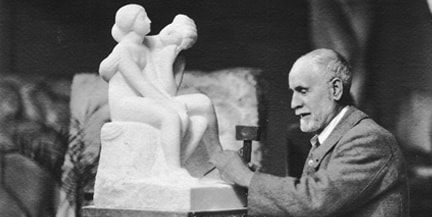
Joseph BERNARD
Son of a stonemason, J. Bernard, who showed little interest in studies, left school at an early age to accompany his father on building sites where he restored the medieval monuments of Vienne. He produced two decorations elements for gates and a head of the Republic, which drew attention to him and enabled him to obtain a scholarship from the city, first to study at the Ecole des Beaux-Arts in Lyon in 1881, then in Paris in 1887.Although he enrolled in Cavelier's studio, he was not very assiduous, as he did not appreciate the modelling that was in vogue at this period and devoted most of his time to painting and drawing, which he studied in the studios of Juste Lefevbre and Gustave Boulanger. In 1891, he decided to give up his studies to begin a long period of solitary work. He was influenced by Rodin for a time, but quickly stops and began exhibiting at the 1892 Salon. In 1921, when he moved house, he destroyed a large part of all the sculptures from this time.
In 1900, he moved to the Cité Falguière, a hive of artists where Modigliani, Brancusi and Czaky worked. As he wished to stay independent, he refused to work as a practitioner for other artists, as many of his colleagues did, and took a job in a print shop at night, devoting himself to his art during the day. In this way, he produced his first works and above all his best-known ones between 1900 and 1921, when he became as well known as Bourdelle and Maillol.
His sculptures are always imbued with a great softness and reflect the lyrical, bucolic themes so dear to the Art Deco period.

